New Bohr model Fluorine and Nitrogen (F, N)
Top page (correct Bohr model including the two-electron atoms).
Electron spin is an illusion !
Our new Bohr model has succeeded in calculating the Helium ionization energy more correctly than the quantum mechanical variational methods as shown in the Top page.
In this new successful Bohr model, the two electrons of the helium atom (He) are moving on the orbits of just one de Broglie's wavelength which are perpendicular to each other.
This model can explain the phenomena of Pauli exclusion principle correctly, because there is no space for the third electron to enter this new two-electron Bohr atom.
Surprisingly, this new atomic structure of the Bohr's helium can be applied to other two-electron atoms (ions ), Lithium ion (Li+), Beryllium (Be2+), Boron (B3+) and Carbon (C4+) ions, too.
(See this page.)
Furthermore, the ionization (ground state) energy of the three-electron atom lithium (Li) can be calculated correctly using the approximate "2S" Bohr orbit. (See this page.)
Bohr model Nitrogen ion (N 4+)
Here we confirm the third electron of nitrogen atom enter the orbit of 2 × de Broglie's wavelength using three-electron Nitrogen ion (N4+).
Nitrogen ion (N4+) has two electrons in 1S orbital, and one electron in 2S orbital.
The two electrons of 1S state are attracted to the 7e+ nucleus strongly, so they are much closer to the nucleus than the 2S electron.
So approximately, we can suppose the 2S electron is moving around the 5e+ nucleus ( +7e - 2e = +5e ) on the circular orbit of the two de Broglie's wavelength.
(This means that we can use the equations of the hydrogen-like atom in 2S electron approximately.)
According to the Bohr hydrogen-like model, the radius (Rb) of the n × de Broglie's wavelength orbit is,
(Eq.1)

(when z =1 and n = 1, this Rb becomes "Bohr radius.")
In 2S electron of N4+, the positive charge of the nucleus (z) is supposed to be 5+ (see above), and n is 2.
So this Rb is 4/5 × Bohr radius ( = 0.4233 × 10-10 meter = 4233 MM ) .
(Here we use the new units, 1 MM = 10-14 meter, 1 SS = 10-22 second, 1 MM/SS = 108 m/s )
The energy levels of the hydrogen-like atom is known to be,
(Eq.2)

In the 2S electron of N4+, we substitute n=2 and z=5 into this equation.
So we suppose the nitrogen ion (N4+) model as follows,
Fig. 1. Nitrogen ion (N4+) model
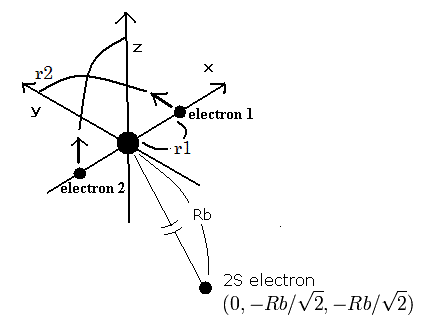
The two electrons of 1S state are avoiding 2S electron, so we fix the 2S electron at ( 0, - Rb / √2, - Rb / √2 ) as shown in Fig. 1.
(Fig. 1. shows the relative positions, But actually, this 2S electron is rotating around the nucleus slower than the 1S electrons.)
Like this page, when the electron 1 is at (x, y, 0), the electron 2 is at ( -x, 0, y ).
So the distances among the particles are,
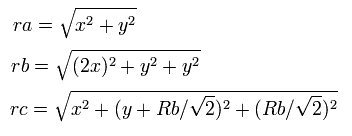
where ra is the distance between the electron 1 and the nucleus, rb is between the two 1S electrons, and rc is between the electron 1 and 2S electron, respectively.
The x component of the acceleration (m/sec2) of the electron 1 is,

In the same way, the y component of the acceleration (m/sec2) of the electron 1 is,

Then we compute the number of de Broglie's waves contained in one quarter of the 1S orbit like other two-electron atoms.
Sample JAVA program (N4+ ion)
(Copy and paste the program inside into a text editor, save this text editor as "MathMethod.java", and compile this.)
Table 1. Ionization energies of the nitrogen atom (eV).
(Experimental values.)
| Name | 1st | 2nd | 3rd | 4th | 5th | 6th | 7th |
|---|
| Nitrogen (N) | 14.53 | 29.60 | 47.45 | 77.47 | 97.89 | 552.07 | 667.046 |
The ground state energy of nitrogen ion (N4+) is the sum of 5-7th ionization energies.
(-97.89 - 552.07 - 667.046 = - 1317.0 eV)
Table. 2 shows the results in which the last VY ( y component of electron 1's velocity after moving one quarter of its orbit ) is the closest to zero in N4+.
Table.2. Results of r1 and WN in which last VY is zero (N4+).
| E (eV) | r1 (MM) | WN | WN x 4 |
|---|
| -1300.0 | 800.0 | 0.25151 | 1.00604 |
| -1305.0 | 796.0 | 0.25099 | 1.00396 |
| -1310.0 | 793.0 | 0.25048 | 1.00192 |
| -1314.5 | 790.0 | 0.25000 | 1.00000 |
| -1320.0 | 786.5 | 0.24945 | 0.99780 |
| -1325.0 | 783.5 | 0.24894 | 0.99576 |
| -1330.0 | 780.0 | 0.24844 | 0.99376 |
This results shows that when the ground state energy of N4+ ion is - 1314.5 eV, the orbital length becomes just 1.00000 × de Broglie's wavelength.
The experimental value of the ground state energy of the nitrogen (N4+) ion is - 1317.0 eV.
So the calculation error is only 2.5 eV ( 0.19 % ).
(This small error is probably caused by using the "approximate" orbit of the 2S electron.)
This means that it is almost correct to say that the three electrons of the nitrogen ion (N4+) are moving like Fig.1.
Bohr model Fluorine ion (F 6+)
Next we confirm the third electron of fluorine atom enter the orbit of 2 × de Broglie's wavelength using three-electron Fluorine ion (F6+).
Like the above section, we can suppose the 2S electron of F6+ is moving around the 7e+ nucleus ( +9e - 2e = +7e ) on the circular orbit of the two de Broglie's wavelength.
(This means that we can use the equations of the hydrogen-like atom in 2S electron approximately.)
In 2S electron of F6+, the positive charge of the nucleus (z) is supposed to be 7+ (see above), and n is 2.
So this Rb is 4/7 × Bohr radius ( = 0.3024 × 10-10 meter = 3024 MM ) .
(See Eq.1 )
And substitute the values (z=7 and n=2) into the above Eq.2, we can know the approximate energy of 2S electron of F6+
We can use the Fig.1 model also in the three-electron F6+.
Like this page, when the electron 1 is at (x, y, 0), the electron 2 is at ( -x, 0, y ).
So the distances among the particles are,

where ra is the distance between the electron 1 and the nucleus, rb is between the two 1S electrons, and rc is between the electron 1 and 2S electron, respectively.
The x component of the acceleration (m/sec2) of the electron 1 is,

In the same way, the y component of the acceleration (m/sec2) of the electron 1 is,

Then we compute the number of de Broglie's waves contained in one quarter of the 1S orbit like other two-electron atoms.
Sample JAVA program (F6+ ion)
(Copy and paste the program inside into a text editor, save this text editor as "MathMethod.java", and compile this.)
Table 3. Ionization energies of the fluorine atom (eV).
(Experimental values.)
| Name | 1st | 2nd | 3rd | 4th | 5th | 6th | 7th | 8th | 9th |
|---|
| Fluorine (F) | 17.42 | 34.97 | 62.71 | 87.14 | 114.24 | 157.16 | 185.18 | 953.91 | 1103.12 |
The ground state energy of fluorine ion (F6+) is the sum of 7-9th ionization energies.
(-185.18 - 953.91 - 1103.12 = - 2242.2 eV)
Table. 4 shows the results in which the last VY ( y component of electron 1's velocity after moving one quarter of its orbit ) is the closest to zero in F6+.
Table.4. Results of r1 and WN in which last VY is zero (F6+).
| E (eV) | r1 (MM) | WN | WN x 4 |
|---|
| -2225.0 | 613.0 | 0.25083 | 1.00332 |
| -2230.0 | 611.0 | 0.25052 | 1.00208 |
| -2235.0 | 610.0 | 0.25023 | 1.00092 |
| -2238.7 | 608.5 | 0.25000 | 1.00000 |
| -2245.0 | 607.0 | 0.24958 | 0.99832 |
| -2250.0 | 605.5 | 0.24931 | 0.99724 |
| -2255.0 | 604.0 | 0.24898 | 0.99592 |
This results shows that when the ground state energy of F6+ ion is - 2238.7 eV, the orbital length becomes just 1.00000 × de Broglie's wavelength.
The experimental value of the ground state energy of the fluorine (F6+) ion is - 2242.2 eV.
So the calculation error is only 3.5 eV ( 0.15 % ).
(This small error is probably caused by using the "approximate" orbit of the 2S electron.)
This means that it is almost correct to say that the three electrons of the fluorine ion (F6+) are moving like Fig.1.
Distribution of 5 valence electrons in Bohr model Nitrogen (N)
In the neutral nitrogen (N), how are five outer-shell electrons moving ?
The neutral nitrogen has seven electrons, in which two 1S electrons are very close to the nucleus (see above N4+ section).
So approximately we suppose these five electrons are moving around one +5e central nucleus (+7e-2e = +5e).
(Here, the total energy of the five valence electrons are supposed to be -266.94 eV = sum of 1-5 ionization energies.)
In the Carbon model, we have succeeded in expressing the carbon atom which has "tetrahedral" structure as shown in Carbon page.
In this program, at short time intervals (1 SS), we calculate the Coulomb forces among electrons and nuclei, and change each velocity vector based on that result.
And we also compute the number of de Broglie's waves contained in the short segments at each electron.
When the central positive charge of carbon is +4.0e (= + 6e - 2e), the orbtal lenghth of outer shell electrons becomes 1.9.
But the two 1S electrons of carbon are about 930 MM apart from +6e carbon nucleus. (They don't stick to the nucleus.)
So, the "effective" positive charge which influences the four valence electrons are probably a little bigger than +4.0e.
We change the central positive charge into +4.25e which is a little bigger than +4.0e.
(As the valence electrons decrease, the remaining valence electrons come closer to +6.0e nucleus, So this influence is included especially in the 3rd and 4th ionization energies of carbon. )
When the orbital length becomes just 2.0 de Broglie's wavelength, all four valence electrons of carbon can return to their original positions, as follows,
Fig. 2. Carbon electrons at wn = 0.0 and wn = 2.0 ("effective" charge = +4.25e)
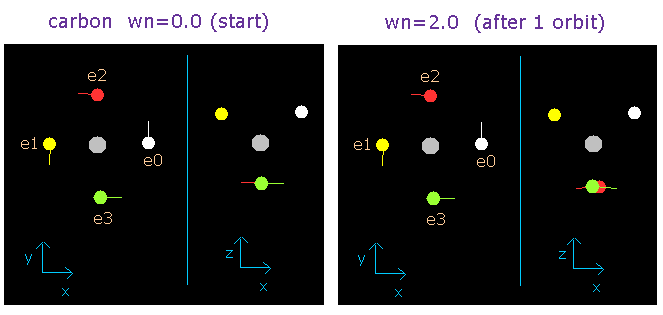
Furthermore, we can prove this using the Virial theorem.
Fig. 3. Carbon valence electrons ("effective" charge = +Ze)
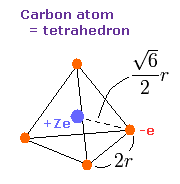
When Z = +4.0, this wn becomes 1.87 (almost 1.9).
And when Z = +4.25, this wn becomes just 2.02.
In the nitrogen atom, it is much more difficult to visualize the electrons' motions than carbon atom.
As the nitrogen has five valence electrons, it can not be expressed as a regular polyhedrons like carbon (tetrahedron), oxygen (octahedron), and neon (hexahedron).
So here, we try to find the "symmetrical" distribution of nitrogen five valence electrons using the next sample program.
Sample JAVA program (distribution of N electrons)
(This program is a little long. So if you copy and paste the program source code into a text editor,
you can easily compile and run this.
This program's class file name is Nit, so save this text editor as "Nit.java", and compile it.)
Fig.4 Distribution of five valence electrons in nitrogen (central charge = +5.25e)
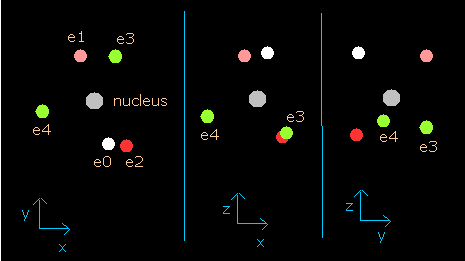
Also in the nitrogen atom (N), the two 1S electrons are a little apart from the +7e nucleus of N.
So the "effective" central charge of this figure is a little bigger than the +5e ( = +7e -2e ).
(Here we use +5.25e, which is 0.25e+ bigger like the carbon case.)
In the above N4+ ion, we use the +5.0e central charge, because at the starting point of Fig.1, the error by this approximate methods is very small.
See also this page (the relation between inner 1S and 2S electrons).
In this program, the nitrogen nucleus is gray.
Here we use the new units, ( 1 MM = 10-14 meter).
Each coordinate of electrons (+X (MM), +Y (MM), +Z (MM)) in the text box means "relative" positions from this nucleus.
"nuc (MM)" means the distance between the nucleus and each electron. (All are the same.)
(You can change these values by entering the values into the text boxes, and press the Enter key.)
V (eV) and T (eV) mean the potential and kinetic energies of each electron.
CF means the force toward the nucleus acting on each electron.
(fx, fy, fz) mean the each component of the "remaining" force other than CF.
(FX, FY, FZ) of the last row mean each component of the force acting on the nucleus.
(The unit of force: 1000 = the force between +e nucleus and an -e electron which are Bohr radius apart from each other.)
tV of the last row is the total potential energy (eV).
Waves (wn) means the number of de Broglie's waves contained in one orbit of each electron.
According to the Virial theorem, "average" total potential (V) and kinetic (T) energies satisfy the relation,
< V > = -2 × < T > , E = V + T
The total energy (E) of the five valence electrons of nitrogen is -266.94 eV (= the sum of the 1-5th ionization energies), so this potential energy (V) becomes 2 × -266.94 = -533.88 eV.
When the valence electrons are distributed "symmetrically" around the nucleus, the distances between electrons and nucleus (nuc) need to be the same in all valence electrons.
And the forces actong on electrons need to be toward the nucleus in the equlibrium state.
In this program, we divide the force (F) acting on each electron into the CF (toward nucleus) and (fx,fy,fz).
So (fx, fy, fz) which means the remaing forces other than CF needs to be as small as possible.
We change the values of coordinates and nuc, and aim to satisfy these conditions.
Based on this force (F) acting on each electron, we define "temporary" radius (r1) as follows,

(This means the "temporary" centrifugal force is supposed to be equal to F.)
Here, m is the electron mass, and v is the electron's velocity which value can be found based on each kinetic energy.
And based on these values, we can find the values (wn) of de Broglie's waves, which is contained in one orbit of each electron, as follows,

As shown in Table. 5, when the total potential energy (tV) of nitrogen valence electrons is - 533.89 eV, this wn (Waves) of each electron becomes almost 2.0.
Table.5. Each parameter of Nitrogen valence electrons (tV=-533.89 eV).
| eNo. | +X (MM) | +Y (MM) | +Z (MM) | nuc (MM) | CF | fx | fy | fz | Waves |
|---|
| ele 0 | 1128 | -3324 | 4013 | 5332 | 3759 | 5 | 11 | 7 | 1.995 |
| ele 1 | -904 | 3746 | 3684 | 5332 | 3750 | -11 | 0 | -2 | 1.985 |
| ele 2 | 2260 | -3618 | -3198 | 5332 | 3746 | -7 | 4 | -9 | 1.98 |
| ele 3 | 2439 | 3754 | -2895 | 5331 | 3761 | 11 | 0 | 9 | 1.997 |
| ele 4 | -5019 | -629 | -1686 | 5332 | 3783 | -2 | 2 | 7 | 2.02 |
You can change the coordinates (+X, +Y, +Z) and nuc (MM) freely.
(When the nuc is changed, these values (nuc) of all electrons automatically become the same.)
If you try changing these values, you will know the de Broglie's waves (Waves) become almost 2.0, when the total potential energy is about -533.89 eV.
This result shows that the all five valence electrons of nitrogen are moving on the orbits of 2 de Broglie's wavelength.
In this case, each component of the force acting on the nucleus becomes (FX, FY, FZ) = (-89, -66, -76), which values are small.
(The unit of force: 1000 = the force between +e nucleus and -e electron which are "Bohr radius" apart from each other.)
Of cource, (fx, fy, fz) of each electron needs to be very small in the equilibrium state.
(I'm grad if you seek better distribution (structure) running this program.)
Distribution of 7 valence electrons in Bohr model Fluorine (F)
In the neutral fluorine (F), how are seven outer-shell electrons moving ?
The neutral fluorine has nine electrons, in which two 1S electrons are very close to the +9e nucleus (see above F6+ section).
So approximately we suppose these seven electrons are moving around one +7e central nucleus (+9e-2e = +7e).
(Here, the total energy of the five valence electrons are supposed to be -658.835 eV = sum of the 1-7th ionization energies.)
Also in the fluorine atom, it is much more difficult to visualize the electrons' motions.
As the fluorine has seven valence electrons, it can not be expressed as a regular polyhedrons like carbon (tetrahedron), oxygen (octahedron), and neon (hexahedron).
So here, we try to find the "symmetrical" distribution of fluorine seven valence electrons using the next sample program.
Sample JAVA program (distribution of F electrons)
(This program is a little long. So if you copy and paste the program source code into a text editor,
you can easily compile and run this.
This program's class file name is Fus, so save this text editor as "Fus.java", and compile it.)
Fig.5 Distribution of seven valence electrons in fluorine (central charge = +7.3e)
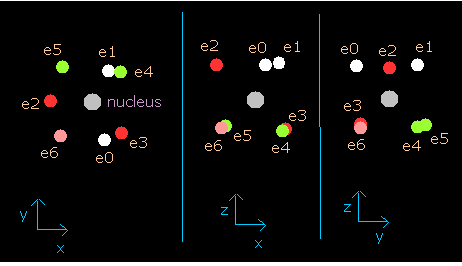
Also in the fluorine atom (F), the two 1S electrons are a little apart from the +9e nucleus of F.
So the "effective" central charge of this figure is a little bigger than the +7e ( = +9e -2e ).
(Here we use +7.3e, which is 0.3e+ bigger like the oxygen case.)
Fig. 6. Oxygen electrons at wn = 0.0 and wn = 2.0 ("effective" charge = +6.3e)
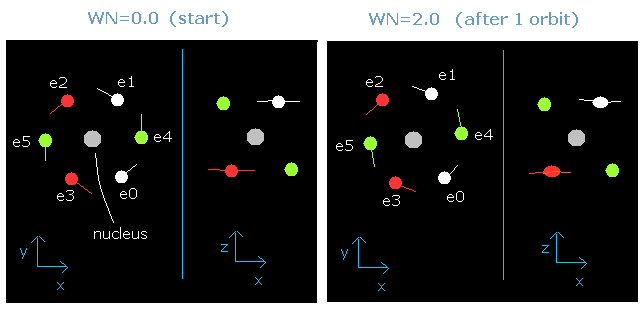
Furthermore, we can prove this using the Virial theorem in the oxygen.
Fig. 7. Oxygen valence electrons ("effective" charge = +Ze)
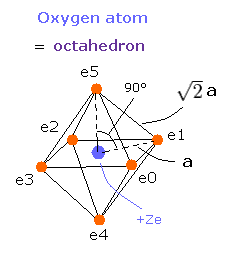
As shown in the oxygen page, when Z = +6.0, this wn becomes 1.88 (almost 1.9).
And when Z = +6.3, this wn becomes just 2.01.
+0.3e ( = +6,3e - 6.0e) is a little bigger than the carbon +0.25e ( = +4.25e - 4.0e ).
As the valence electrons decrease, the remaining valence electrons come closer to +8e nucleus in the oxygen.
(So this effect is included especially in the 4-6th ionization energies of oxygen).
Probably the oxygen electrons can come closer to the nucleus than those of the carbon due to the stronger nuclear force.
In this program, the fluorine nucleus is gray.
Here we use the new units, ( 1 MM = 10-14 meter).
Other manipurations and calculation methods are the same as the upper nitrogen.
According to the Virial theorem, "average" total potential (V) and kinetic (T) energies satisfy the relation,
< V > = -2 × < T > , E = V + T
The total energy (E) of the seven valence electrons of fluorine is -658.835 eV (= the sum of 1-7 the ionization energies), so this potential energy (V) becomes 2 × -658.835 = -1317.67 eV.
As shown in Table. 6, when the total potential energy (tV) of fluorine valence electrons is - 1317.77 eV, this wn (Waves) of each electron becomes almost 2.0.
Table.6. Each parameter of Fluorine valence electrons (tV=-1317.77 eV).
| eNo. | +X (MM) | +Y (MM) | +Z (MM) | nuc (MM) | CF | fx | fy | fz | Waves |
|---|
| ele 0 | 1003 | -2774 | 2707 | 4004 | 8834 | -8 | 0 | 2 | 1.993 |
| ele 1 | 1656 | 2376 | 2763 | 4003 | 8853 | -1 | 0 | 0 | 2.001 |
| ele 2 | -3137 | 252 | 2475 | 4003 | 8825 | 1 | 0 | 1 | 1.988 |
| ele 3 | 2567 | -2408 | -1907 | 4004 | 8804 | 0 | -1 | 1 | 1.979 |
| ele 4 | 2552 | 2277 | -2081 | 4004 | 8796 | -4 | 0 | -5 | 1.975 |
| ele 5 | -2256 | 2721 | -1879 | 4004 | 8833 | -3 | 1 | 6 | 1.992 |
| ele 6 | -2416 | -2451 | -2045 | 4004 | 8854 | 3 | 0 | -3 | 2.001 |
You can change the coordinates (+X, +Y, +Z) and nuc (MM) freely.
If you try changing these values, you will know the de Broglie's waves (Waves) become almost 2.0, when the total potential energy is about -1317.77 eV.
This result shows that the all seven valence electrons of fluorine are moving on the orbits of 2 de Broglie's wavelength.
In this case, each component of the force acting on the nucleus becomes (FX, FY, FZ) = (-96, -18, -100), which values are small.
(The unit of force: 1000 = the force between +e nucleus and -e electron which are "Bohr radius" apart from each other.)
Of cource, (fx, fy, fz) of each electron needs to be very small in the equilibrium state.
(I'm grad if you seek better distribution (structure) running this program.)

2010/11/4 updated. Feel free to link to this site.
















